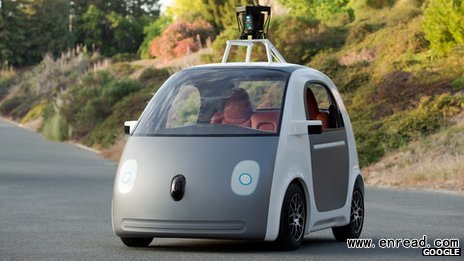| ||||||||||||||||||||||||||||||||||||||||||||||||||||||||||||||||||||||||||||||||||||||||||||||||||||||||
|
Google is to start building its own self-driving cars, rather than modifying vehicles built by other manufacturers.
谷歌将着手打造属于自己的自动驾驶汽车,而不是在其它厂商的车型上修改。
 Google says it expects its self-drive cars to be on the road 'within a year' Pictures of the Google vehicle show it looks like a city car with a "friendly" face, designed to make it seem non-threatening and help people accept self-driving technology.
Co-founder Sergey Brin revealed the plans at a conference in California.
"We're really excited about this vehicle - it's something that will allow us to really push the capabilities2 of self driving technology, and understand the limitations," said Chris Urmson, director of the company's self-driving project.
But some researchers working in this field are investigating potential downsides to driverless car technology.
They believe they could make traffic and urban sprawl4(城市扩张) worse, as people accept longer commutes5 as they do not have to drive themselves.
Flexible windscreen
The BBC was given access to the Google team to talk about the secret project, and see early renderings6 of the car.
It looks almost cartoon-like, it has no traditional bonnet7 at the front, and the wheels are pushed to the corners.It will seat two people, propulsion will be electric, and at the start it will be limited to 25mph (40km/h) to help ensure safety.
The most significant thing about the design is that it does not have any controls, apart from a stop/go button.
For early testing, extra controls will be fitted so one of Google's test drivers can take over if there is a problem.
The controls will simply plug in, and Mr Urmson believes that over time, as confidence in the technology grows, they will be removed entirely8.
The front end of the vehicle is designed to be safer for pedestrians9, with a soft foam-like material where a traditional bumper10 would be, and a more flexible windscreen, which may help reduce injuries.
The vehicle will use a combination of laser and radar11 sensors12 along with camera data to drive autonomously13.
It will depend on Google's road maps, built specifically for the programme, and tested on the company's current fleet of vehicles.
It will seat two people, propulsion will be electric, and at the start it will be limited to 25mph (40km/h) to help ensure safety.
The most significant thing about the design is that it does not have any controls, apart from a stop/go button.
For early testing, extra controls will be fitted so one of Google's test drivers can take over if there is a problem.
The controls will simply plug in, and Mr Urmson believes that over time, as confidence in the technology grows, they will be removed entirely.
The front end of the vehicle is designed to be safer for pedestrians, with a soft foam-like material where a traditional bumper would be, and a more flexible windscreen, which may help reduce injuries.
The vehicle will use a combination of laser and radar sensors along with camera data to drive autonomously.
It will depend on Google's road maps, built specifically for the programme, and tested on the company's current fleet of vehicles.
点击  收听单词发音 收听单词发音
|
||||||||||||||||||||||||||||||||||||||||||||||||||||||||||||||||||||||||||||||||||||||||||||||||||||||||
上一篇:口服防晒霜首次问世 下一篇:三星发布世界首款Tizen智能手机 |
||||||||||||||||||||||||||||||||||||||||||||||||||||||||||||||||||||||||||||||||||||||||||||||||||||||||
- 发表评论
-
- 最新评论 进入详细评论页>>



